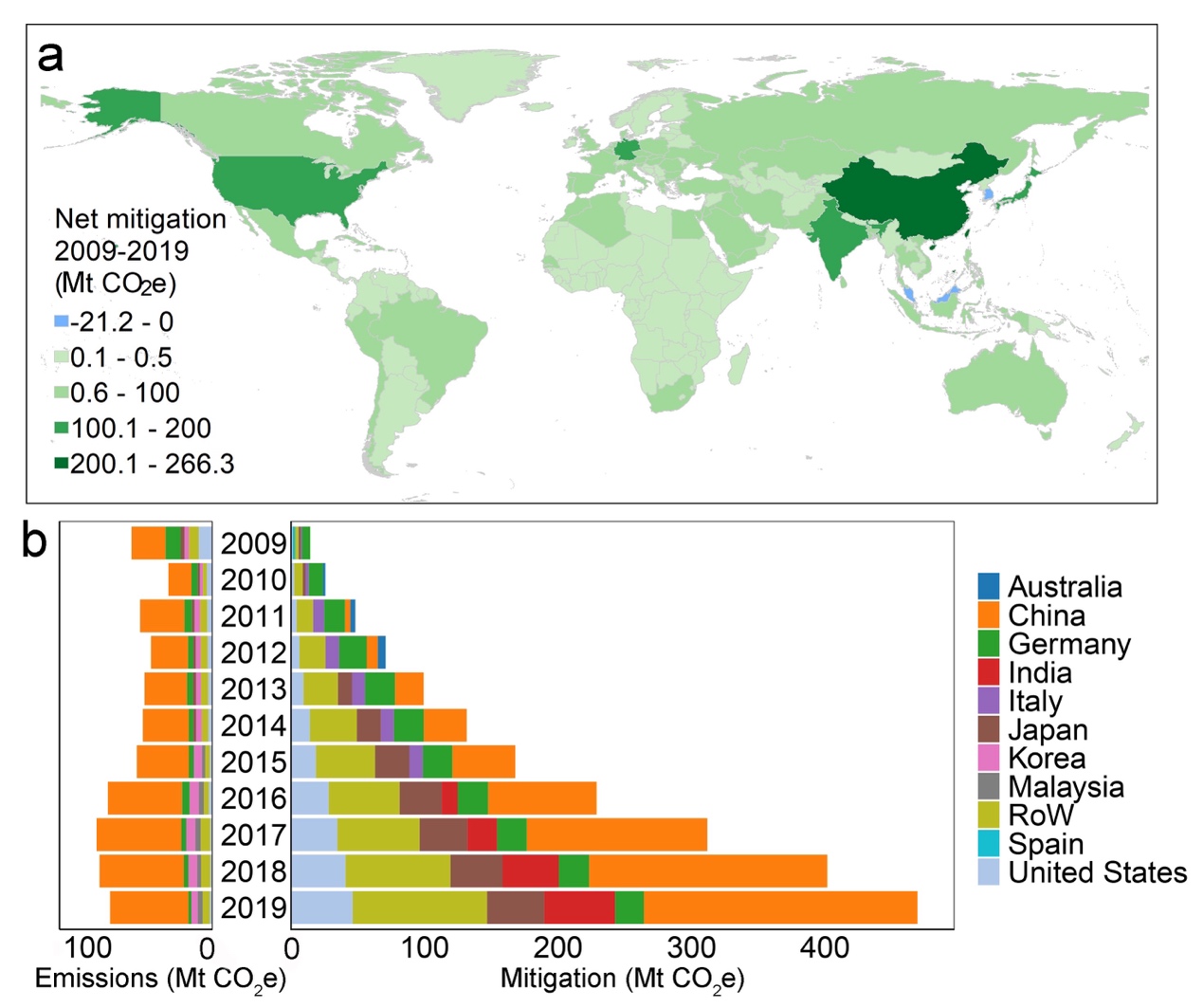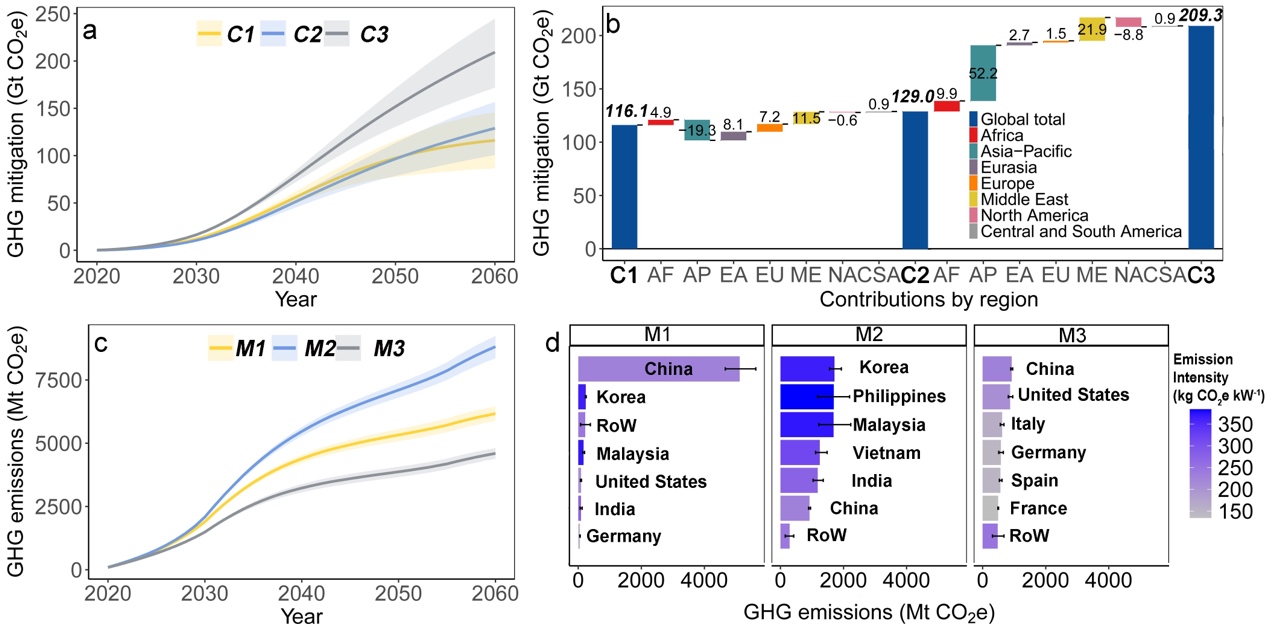Driven by the global net-zero emissions goal, photovoltaic power generation is set to become a crucial driving force for future global greenhouse gas (GHG) mitigation. Therefore, it is of paramount importance to clarify the emissions and mitigation characteristics of its entire industry chain to fully leverage its low-carbon benefits. In recent years, the global distribution pattern of the photovoltaic industry chain has exhibited complex and dynamic features, with significant regional disparities, showing a trend of clustering towards China on both the manufacture and installation sides. Apart from the distribution of the industry chain, emissions and mitigation characteristics are also influenced by differences in emissions and mitigation intensities in different countries' industry chains. To elucidate the spatiotemporal characteristics of emissions and mitigation under the influence of multiple factors, Professor Lu Xi's team at Tsinghua University's School of Environment, in collaboration with academics from both domestic and international institutions, has developed a spatialized-dynamic life-cycle assessment method. Building upon the analysis of industry distribution patterns and the spatial-temporal evolution of emissions and mitigation intensities, they conducted a comprehensive assessment of the historical and future emissions and mitigation characteristics of the global industry chain.
The study defines net GHG mitigation as the GHG mitigation achieved using photovoltaic power generation technology minus the emissions from the photovoltaic industry chain, depicting the effectiveness of each country's use of photovoltaic technology for low-carbon transition (Figure 1). During the period from 2009 to 2019, the global cumulative net GHG mitigation was approximately 1,288.5 million tons of carbon dioxide equivalent (CO2e), equivalent to 0.36% of global CO2 emissions during the same period. Among this, photovoltaic installed capacity contributed 1,968.8 million tons of CO2e mitigation, while emissions of 680.3 million tons from the photovoltaic industry chain partially offset this mitigation. The top five countries with the highest net mitigation contributions are China, Japan, the United States, Germany, and India, contributing 266.3 million tons, 198.2 million tons, 167.9 million tons, 157.3 million tons, and 144.0 million tons of net GHG mitigation respectively, totaling 72.5% of the global total. China contributed 35.8% of the global photovoltaic GHG mitigation, and 66.1% of the GHG emissions from the global industry chain, with over 50% of China's emissions serving the photovoltaic installation market in other countries.

Figure. 1. Significant spatial difference in net GHG mitigation of global solar photovoltaic power generation. (a) National distribution characteristics of net GHG mitigation from 2009 to 2019; (b) Global trends in GHG mitigation and emissions, and major contributing countries from 2009 to 2019
The global distribution pattern is influenced not only by global manufacture and installation patterns but also by the spatiotemporal dynamics in emissions and mitigation intensity in different countries. Looking at emissions intensity, countries experienced a decline in emission intensity to varying degrees, thanks to the improvement of power grid emissions factor, technological progress, and efficiency improvement in manufacture processes. China, as the largest manufacturer, saw a 79.2% decrease in emissions intensity per kilowatt of photovoltaic power generation system from 2009 to 2019. Regarding mitigation intensity, namely the GHG mitigation per unit installed capacity, global mitigation intensity decreased by 11.1% from 2009 to 2019. There were significant differences in the rate of decline among regions. Due to the rapid decarbonization process in the power sector, the mitigation intensity in Europe decreased the most, with a decline of 24.9% during the same period, while Africa and Eurasia saw reductions of only 5.4% and -3.7%, respectively.
Against the backdrop of countries implementing trade protection and policies to enhance independent manufacture capacity, there is considerable uncertainty in the future global photovoltaic industry chain. The study assessed the net GHG mitigation of the global photovoltaic industry chain in the future by combining three types of manufacture and installation scenarios (Figure 2). The research indicates that the installation scenario has a more significant impact on the net GHG mitigation total. By 2060, if new installations lock in the current pattern (C1), the cumulative GHG mitigation will be between 86.5 billion and 145.8 billion tons. If new installations are balanced across nations (C2), the GHG mitigation will increase to between 100.7 billion and 156.6 billion tons. If the installation development sequence is further optimized to fully utilize the comparative advantages in GHG mitigation intensity among nations (C3), global GHG mitigation will further increase to between 171.7 billion and 244.7 billion tons. In this optimized scenario, the installation capacity in Africa, Eurasia, the Middle East, and Southeast Asia will significantly increase.

Figure. 2. Spatiotemporal dynamics in global solar photovoltaic power generation GHG emissions and mitigation under multiple scenarios from 2020 to 2060. (a) Cumulative GHG mitigation; (b) Differences in GHG mitigation among different installation scenarios and regional contributions; (c) Cumulative emissions levels; (d) Country-specific contributions to industry chain emissions under different manufacture scenarios
The combination of optimal installation and manufacture scenarios will bring an additional 97.5 billion tons of net GHG mitigation to the global industry chain, approximately equivalent to 1.9 times the global GHG emissions in 2020 or 23.2% of the remaining carbon emission quota under the 1.5°C global warming target. By reviewing and predicting the spatiotemporal characteristics of GHG emissions and mitigation in the global photovoltaic industry chain, this study reveals China's historical contributions to the global photovoltaic industry's GHG mitigation from an environmental perspective. The differences in the net GHG mitigation intensity and mitigation under various scenarios anticipated by the study provide fundamental insights and lessons for promoting global cooperation to accelerate the GHG mitigation of global photovoltaic power generation. It also highlights the need to pay special attention to the variation characteristics of environmental and climate benefits of technology under different spatial and temporal conditions when developing and applying low-carbon technologies, thereby assisting in the formulation of more efficient decisions.
The research findings, titled "Deploying solar photovoltaic energy first in carbon-intensive regions brings gigatons more carbon mitigations to 2060", were recently published online in the journal "Communications Earth & Environment" by Springer Nature.
Dr. Chen Shi, a postdoctoral researcher at Tsinghua University School of Environment, is the first author of the article. Professor Lu Xi from the School of Environment and Professor Michael B. McElroy from Harvard University are co-corresponding authors. Academician Hao Jiming, Academician He Kebin, Chris P. Nielsen, Executive Director of the Harvard China Project, Assistant Professor He Gang from the City University of New York, Zhang Shaohui, a research scholar from the International Institute for Applied Systems Analysis, Yang Xiu, Assistant to the Dean and Research Director of the Institute of Climate Change and Sustainable Development at Tsinghua University, and Assistant Professor Zhang Fang from the School of Public Policy and Management at Tsinghua University are co-authors.
This research received support from the Natural Science Foundation of China, Tsinghua University-INDITEX Sustainable Development Fund, the Ordos-Tsinghua Innovative & Collaborative Research Program in Carbon Neutrality, the Tsinghua-Toyota Joint Research Institute Cross-discipline Program, Office of the President of Harvard University and the Harvard Global Institute grants to the Harvard-China Project on Energy, Economy, and Environment, the Postdoctoral Innovative Talent Support Program, and Shui Mu Tsinghua Scholar Program.
Article link: https://www.nature.com/articles/s43247-023-01006-x





